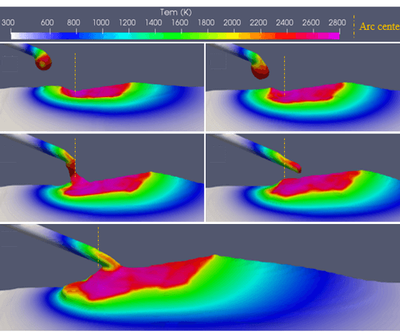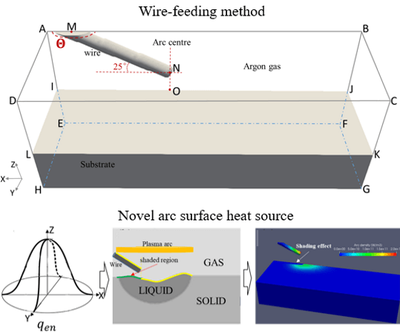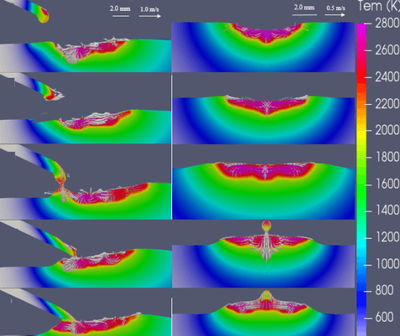


3D wire feeding modelling framework for plasma arc AM
A three-dimensional wire-feeding model has been developed to study the transient coupling behaviour of heat and metal transfer, fluid flow, and solidified bead shape in wire plasma arc additive manufacturing (WPAAM). A novel surface heat source model considering the arc energy shading effect is proposed and adopted. An improved momentum source of the arc force considering the arc pressure shading effect is also developed and used. This model has been used to study the metal transfer dynamics, flow patterns, and bead shape of the WPAAM process with a wire-feeding speed (WFS) of 1–5 m/min. The simulated results agreed reasonably with the experimental data. As the WFS increased from 1 to 5 m/min, three different metal transfer modes were observed, which changed from globular droplet mode to droplet-liquid bridge mode and solid-liquid bridge mode. Detailed metal transfer information was analysed, including metal transfer position, shape, average temperature, and main driving force. The effects of the arc shading and metal transfer on the melt pool dynamics and bead shape were simulated and discussed. A periodic flow pattern of the melt pool produced by the metal transfer impact causes ripples or even humping defects. As the WFS increased, the melt pool depression gradually disappeared due to the arc pressure shading effect. When the WFS increased to 5 m/min, a temperature drop of about 140 K in the central melt pool, caused by the arc energy shading effect and cold metal transfer, weakened the lateral flow significantly, which explained the decrease of bead width at a large WFS. The results demonstrate that the developed wire-feeding model and findings could be used as a theoretical tool and basis to better understand the underlying physical mechanisms and achieve bead shape control in the WAAM process.
Chen, C. Wang, J. Ding, P. Bridgeman, and S. Williams, “A three-dimensional wire-feeding model for heat and metal transfer, fluid flow, and bead shape in wire plasma arc additive manufacturing,” J Manuf Process, vol. 83, pp. 300–312, Nov. 2022, doi: 10.1016/J.JMAPRO.2022.09.012.
Information
- Research Area:Process Modelling
-
Investigators:
Chong Wang
, Xin Chen, Stewart Williams - Publications:https://doi.org/10.1016/j.jmapro.2022.09.012
